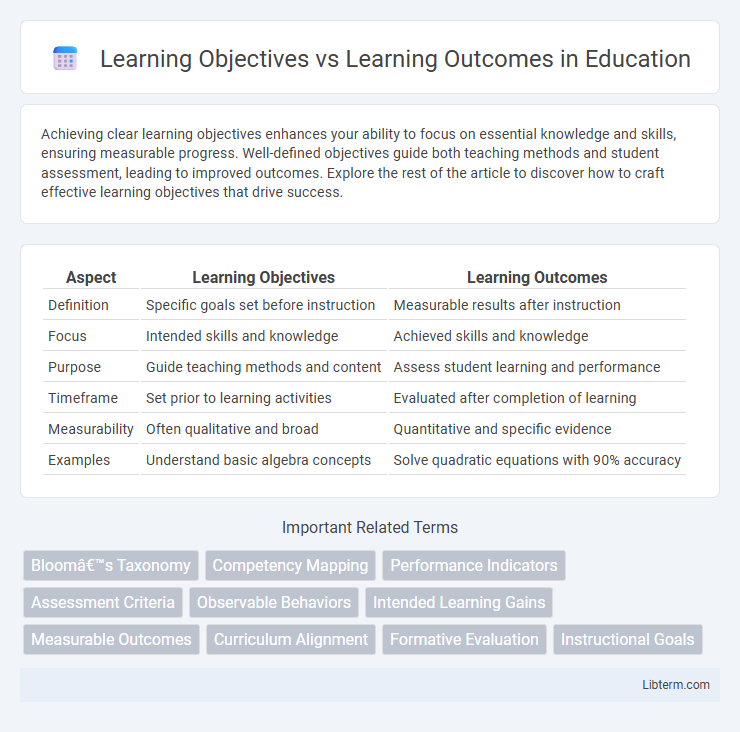Achieving clear learning objectives enhances your ability to focus on essential knowledge and skills, ensuring measurable progress. Well-defined objectives guide both teaching methods and student assessment, leading to improved outcomes. Explore the rest of the article to discover how to craft effective learning objectives that drive success.
Table of Comparison
| Aspect | Learning Objectives | Learning Outcomes |
|---|---|---|
| Definition | Specific goals set before instruction | Measurable results after instruction |
| Focus | Intended skills and knowledge | Achieved skills and knowledge |
| Purpose | Guide teaching methods and content | Assess student learning and performance |
| Timeframe | Set prior to learning activities | Evaluated after completion of learning |
| Measurability | Often qualitative and broad | Quantitative and specific evidence |
| Examples | Understand basic algebra concepts | Solve quadratic equations with 90% accuracy |
Understanding Learning Objectives
Learning objectives specify the intended skills, knowledge, or attitudes that learners should acquire during a course or training session. They serve as clear, measurable targets that guide instructional design and assessment strategies. Understanding learning objectives ensures alignment between teaching methods and desired educational achievements.
Defining Learning Outcomes
Learning outcomes clearly define what learners are expected to know, understand, or be able to do after completing a course or module, emphasizing measurable and specific skills or knowledge. Unlike learning objectives, which describe the intent or process of instruction from the educator's perspective, learning outcomes focus on the learner's achievements and competencies. Well-defined learning outcomes guide assessment design and align instructional activities to ensure effective skill acquisition and mastery of content.
Key Differences Between Objectives and Outcomes
Learning objectives specify the intended skills or knowledge that learners should acquire by the end of a lesson or course, focusing on the teaching process. Learning outcomes describe the measurable end results of what learners have actually achieved, emphasizing the learner's performance. Key differences include objectives being instructor-centered and process-oriented, while outcomes are learner-centered and result-oriented, often used to assess effectiveness and success.
The Role of Learning Objectives in Curriculum Design
Learning objectives guide curriculum design by clearly defining the specific skills and knowledge students are expected to acquire, ensuring alignment with educational standards and assessment methods. They provide a structured framework for instructors to develop instructional materials, activities, and evaluations that target measurable competencies. Emphasizing precise learning objectives enhances curriculum coherence and supports targeted student progression throughout the educational program.
Importance of Learning Outcomes in Assessment
Learning outcomes provide clear, measurable criteria that guide the assessment process, ensuring students demonstrate the knowledge, skills, or attitudes intended by the curriculum. Precise articulation of learning outcomes enables educators to design valid assessment tools that align with expected competencies, improving the accuracy of student evaluation. Emphasizing learning outcomes enhances feedback quality and supports targeted instructional improvements, fostering effective educational development.
How to Write Effective Learning Objectives
Effective learning objectives are specific, measurable, and focused on observable student behaviors, clearly defining what learners should know or be able to do after instruction. Use action verbs aligned with Bloom's Taxonomy to articulate precise cognitive, affective, or psychomotor goals, ensuring objectives guide both teaching methods and assessments. Writing objectives in a SMART format--Specific, Measurable, Achievable, Relevant, and Time-bound--enhances instructional clarity and aids in evaluating learning success.
Crafting Measurable Learning Outcomes
Crafting measurable learning outcomes requires defining specific, observable, and assessable skills or knowledge that students should demonstrate after instruction. Unlike broad learning objectives, measurable learning outcomes incorporate action verbs aligned with Bloom's Taxonomy, such as "analyze," "create," or "evaluate," ensuring clarity in assessment criteria. This precision facilitates effective curriculum design, targeted instruction, and accurate evaluation of student progress.
Aligning Objectives and Outcomes for Academic Success
Learning objectives specify the intended skills and knowledge students should acquire, while learning outcomes describe the demonstrable evidence of student achievement. Aligning objectives with outcomes ensures curriculum coherence and drives targeted assessments to measure student progress accurately. Consistent alignment fosters academic success by providing clear expectations and actionable feedback throughout the learning process.
Common Mistakes in Setting Objectives and Outcomes
Common mistakes in setting learning objectives and outcomes include using vague language that lacks specificity, which hinders measurable assessment. Objectives often confuse activities or content coverage with actual learner performance, leading to unclear expectations. Another frequent error is failing to align objectives with outcomes, resulting in a disconnect between what is taught and what learners demonstrate.
Best Practices for Implementing Objectives and Outcomes in Education
Effective implementation of learning objectives and outcomes requires clear, measurable, and student-centered statements that guide instructional design and assessment. Best practices emphasize aligning objectives with outcomes to ensure coherence, using Bloom's Taxonomy to define cognitive levels, and regularly reviewing objectives based on learner feedback and performance data. Embedding these practices enhances curriculum transparency, facilitates targeted teaching strategies, and improves overall educational effectiveness.
Learning Objectives Infographic

 libterm.com
libterm.com